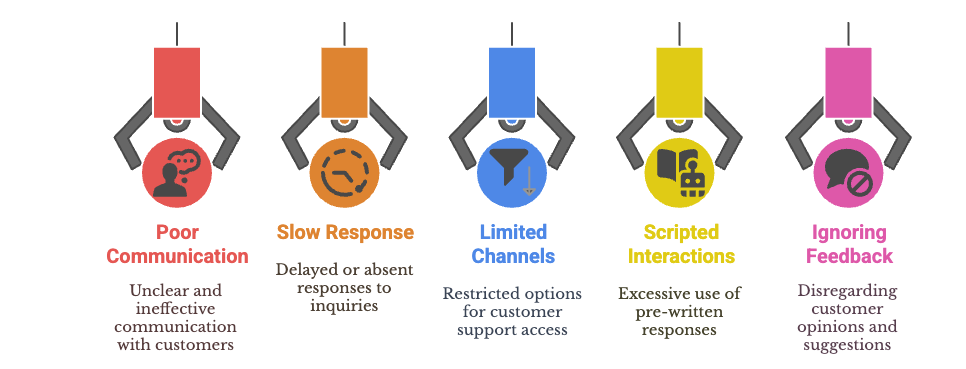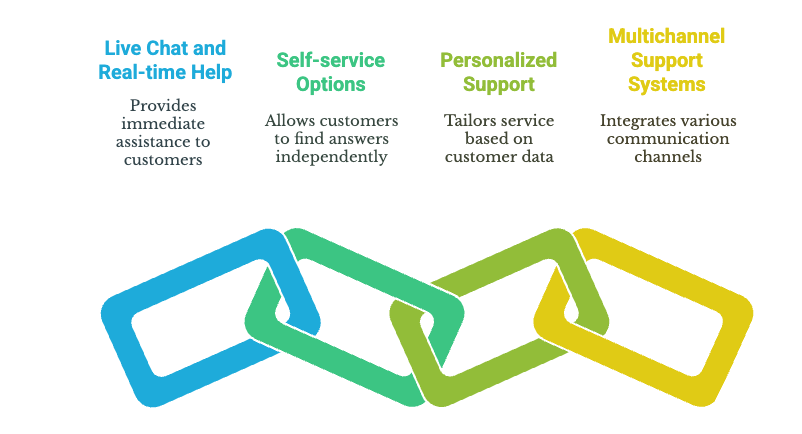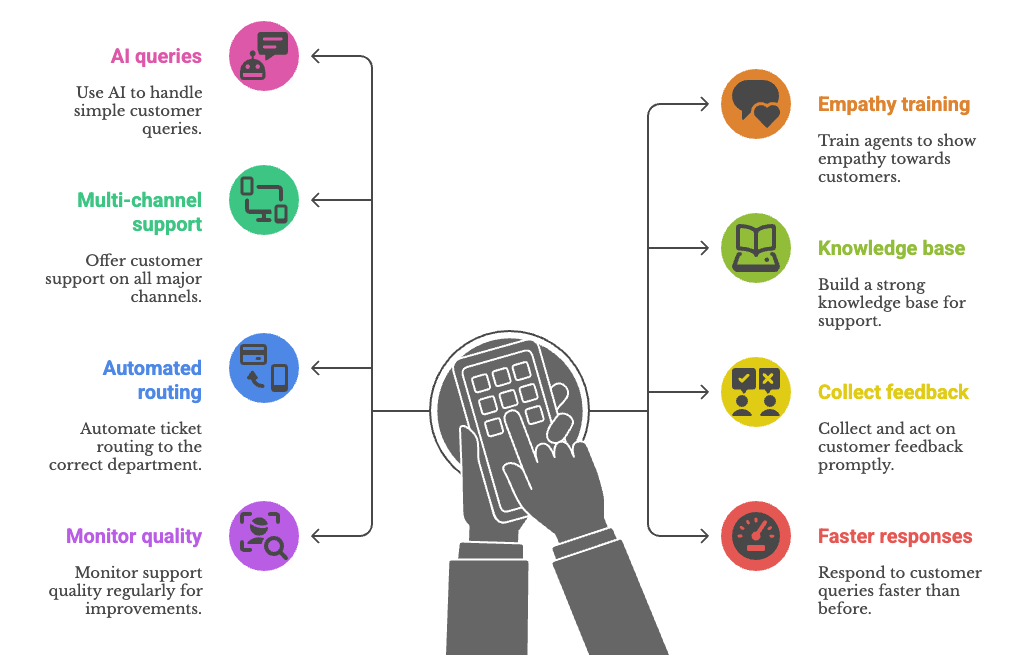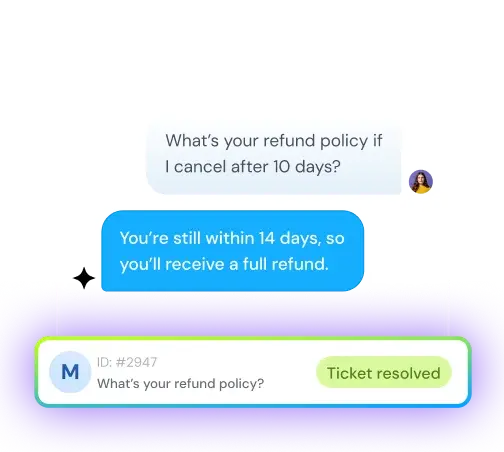Why most online customer support fails (and how to fix it today)
Sneha Arunachalam
May 26, 2025
-900x514.png)
Nobody wants to feel ignored — especially when they need help. But that’s exactly what’s happening with most online customer support today. Customers reach out, and what do they get? Long wait times, unhelpful replies, or worse — total silence.
It’s not just frustrating. It’s expensive. For brands, every slow response chips away at trust. And trust is hard to win back.
Here’s the reality: 76% of customers say quick responses make them loyal to a brand. But too many companies are still stuck in slow motion — trapped by clunky systems, poor communication, or support that’s only available on one or two channels.
Meanwhile, your online customer support team is your brand in the digital world. If that presence feels cold, confused, or MIA, customers won’t stick around.
The problem isn’t a lack of tools — businesses are investing in all the right software, just not using it the right way. They forget that support is about connection, not just automation.
But here’s the good news: it doesn’t take a total overhaul to fix this. In fact, 70% of customer experience leaders are already using AI to handle the simple stuff faster. And 60% of support teams are now active across three or more channels, meeting customers where they actually are.
So if your online support isn’t working like it should, keep reading. These nine practical fixes can turn things around — fast.
Why online customer support often fails

Most customers abandon a company after just one poor support experience. That's not surprising, is it? One bad interaction and they're gone — possibly forever. Let's dig into why so many support teams keep dropping the ball and driving customers crazy.
Lack of clear communication
Clear communication is everything in customer support. But wow, do companies mess this up. When your support team can't understand what customers need or explain solutions properly, trust vanishes almost instantly.
This communication breakdown happens in a bunch of different ways:
- Language barriers — With about 17.4% of US workers being foreign-born, language differences create confusion both inside teams and with customers
- Confusing jargon — Using technical terms without explaining them is like speaking another language to most people
- Poor tone — Cold, robotic messages make customers feel like numbers instead of humans
The fallout is serious. Research shows 52% of customers stop buying from brands due to poor communication, and 17% specifically mention insensitive interactions as their main reason for walking away.
Slow or no response times
Nobody has patience anymore — and why should they? Almost a third of customers expect answers within five minutes when they call support. For chat, a whopping 77% of US customers want instant responses.
Reality check: businesses typically take up to 12 hours for email and five hours for social media replies. That gap between what customers want and what they get? It's massive.
Think about this — almost 60% of people say waiting more than a minute on hold is too long, and about the same percentage will just hang up after 60 seconds. Slow responses don't just annoy people; they make them disappear completely.
Limited support channels
Here's the thing — customers bounce between three to five different channels when looking for help. But many businesses either offer too few options or can't manage multiple channels well.
Each channel comes with its own headaches:
Email support often means waiting hours or days for answers — totally frustrating when you have an urgent problem. Phone support keeps people on hold forever. And social media? Companies struggle to connect social accounts with customer profiles, making it hard to know who needs what.
To make matters worse, 90% of customers expect replies within 10 minutes or less. Without a single view of the customer across channels, people end up repeating their problem over and over. Talk about frustrating.
Over-reliance on scripts
Scripts are supposed to make support consistent, but they usually do the opposite. Research shows 84% of customers have a much better experience when agents don't sound like robots reading from a script.
The problem comes from how companies think about support. Many see it as a cost to minimize rather than a value to maximize. So they create rigid systems focused on efficiency instead of actually helping people.
Those standard phrases like "I understand your frustration" or "I apologize for any inconvenience" have become so overused they actually make customers angrier. These fake-sounding interactions turn what should be human conversations into irritating experiences.
Ignoring customer feedback
This one might be the worst offense — companies ask for feedback and then totally ignore it. A shocking 72% of customers say they never hear back after completing surveys. Even more telling, 71% believe businesses won't actually make changes based on what they say.
This silence sends a clear message: we don't really care. When customers take time to share detailed thoughts and get nothing back, they feel their effort was wasted. As one person put it, "I often wonder if my comments will ever be read by a human, or will they just disappear down a hole".
The consequences? Companies keep losing customers without understanding why. Plus, all those valuable insights that could drive improvements vanish into thin air, giving more attentive competitors a serious edge.
These five critical failures explain why so much online customer support falls flat. Recognizing these problems is step one in building support that creates loyalty instead of frustration.
Apart from these common pitfalls, there’s one often-overlooked aspect that silently hurts support efficiency — unresolved ticket backlogs. If your team is struggling with piling requests, here’s a practical guide on how to reduce customer service ticket backlog effectively.
The hidden cost of poor online customer service

Poor online customer service is bleeding companies dry — $3.7 trillion annually worldwide. That's up 19% from last year. Ouch. But the real damage goes way deeper than just the money.
Loss of customer trust
Think of it like this: customer service should be where you rebuild wobbling trust. Instead, it's often where trust shatters completely. Two-thirds of customers walk away from support interactions feeling totally unsatisfied. Tech companies have felt this sting hardest, tumbling from first to ninth place in trusted sectors between 2020 and 2021.
Trust isn't just some warm fuzzy feeling — it directly hits your bottom line. When customers trust you, 64% will spend more with your company. But when that trust breaks? The numbers get scary fast:
- 67% actively tell others to avoid your business
- 67% stop using your company completely
- 78% go hunting for someone else to buy from
- 55% leave those painful negative reviews online
During tough economic times, that trust foundation becomes even more crucial. Miss the mark with online support, and you'll watch your customer base slowly disappear.
Negative brand reputation
Your brand reputation is basically just the sum of every customer experience over time. And here's the kicker — 91% of consumers make buying decisions based on what they read in online reviews. One bad support experience can snowball into a reputation nightmare.
Bad experiences spread way faster than good ones. In the old days, unhappy customers might tell seven friends about a terrible interaction. Now? Social media turns that whisper into a shout. Just one negative review can reach thousands, with over 30% of people avoiding businesses after seeing a single bad review.
As one expert puts it, "Your online reputation is just a mirror image of how you conduct business". When your support fails, that mirror shows a damaged brand that's incredibly hard to fix.
Increased churn rates
The numbers don't lie — 66% of consumers dump companies specifically because of poor customer service. This exodus is the most immediate cost of bad online support. The latest data from 2024 shows 64% of customers will find another company no matter how much they love your product if your service stinks.
This hurts financially in a big way. Getting new customers typically costs 5-25 times more than keeping the ones you already have. After bad experiences, customers reduce or completely stop spending with brands 51% of the time, creating an immediate revenue hit.
No wonder businesses lose approximately $856 billion annually in the US alone due to poor customer service. Some industries get hit worse than others — after a negative experience, customers are most likely to completely abandon auto dealers (22%).
Lower customer lifetime value
Customer lifetime value measures all the money a customer will spend with you throughout your entire relationship. Bad support puts this at serious risk. When customers leave before you've even earned back what it cost to acquire them, your bottom line takes a beating.
The stats show 58% of consumers stop doing business with companies after just one poor service experience. Beyond losing that immediate sale, you also kiss goodbye to:
- All that future recurring revenue
- Positive word-of-mouth that brings in new customers
- Potential referrals (94% of happy customers would recommend companies they trust)
This hits subscription businesses especially hard, where your entire business model depends on keeping customers around long-term. Poor support is a "surefire way to lose customers", making every support interaction a critical moment for protecting future revenue.
Customer expectations keep climbing too — 85% now say they'll go out of their way for better service (up from 76% last year). Companies that recognize these hidden costs and actually invest in quality support gain a massive advantage over competitors still treating service as an afterthought.
Key elements of effective online customer service

Let's face it — most of us have abandoned a website after a frustrating support experience. But when customer service works well? It feels almost magical. So what makes the difference between support that drives customers away and support that builds loyalty?
Live chat and real-time help
Think of live chat like having a helpful store associate ready to answer questions while you browse. When done right, it's incredibly powerful — 85% of customers feel satisfied after using live chat, higher than any other support channel.
The numbers don't lie here. Companies see a 48% boost in revenue per chat hour and a 40% jump in conversion rates. Why? Because nobody likes abandoning a full shopping cart just because they can't get a simple question answered.
Want to make live chat actually work for your business? Try these:
- Put chat options where customers actually need help, not hidden in some forgotten corner of your site
- Let AI handle the simple stuff before a human jumps in
- Train your team to sound like real humans, not robots reading from scripts
- Use what you know about the customer's journey to personalize the conversation
Live chat isn't just about fixing problems — it's a sales tool in disguise. Businesses typically see conversion rates jump by over 20% after adding live chat. Makes sense, right? We all appreciate a helpful nudge when we're on the fence about buying something.
Self-service options like FAQs
We've all been there — it's 2 AM and you just want to solve a simple problem without talking to anyone. That's where self-service comes in. A massive 81% of customers expect self-service options, but only 15% feel happy with what's currently offered. Talk about a gap worth filling!
Don't just dump information into a knowledge base and call it a day. Focus on answering the questions customers actually ask. Your knowledge base should feel like a helpful friend who's available 24/7, not an overwhelming encyclopedia.
The payoff is huge — 65% of customer care leaders say better self-service options reduced their call volumes. That means your team can focus on the complex stuff that really needs a human touch.
Self-service isn't going anywhere. In fact, 77% of support leaders plan to invest more in this area next year, and 88% of customers now expect brands to have self-service portals. If you're not on board yet, you're already behind.
Personalized support using customer data
Nobody wants to feel like just another ticket number. Small personalization touches can make a huge difference without requiring creepy levels of data mining.
Ever abandoned a shopping cart and gotten a friendly reminder email? Or noticed a website showing you items you recently viewed? These little touches show you're paying attention to the individual customer journey.
When your support team can see a customer's history, purchases, and preferred channels all in one place, magic happens. They can skip the "please explain your entire life story" routine and jump straight to solving the actual problem.
Omni-channel support systems
Most customers bounce between three to five different channels when looking for help. Maybe they start with your FAQ, then try chat, and finally send an email. If you're only offering one or two ways to reach you, you're missing connections.
The most frustrating thing? Having to repeat yourself over and over as you get transferred between agents or channels. About 61% of customers hate this experience, and honestly, who can blame them?
Meeting customers where they are makes all the difference. While 44% of Gen Z might reach out on social media, email is still their top choice, and older folks generally prefer a good old-fashioned phone call. The key isn't being everywhere — it's creating a consistent experience no matter how someone reaches out.
8 ways to fix your online customer support today

Ready to stop losing customers over bad support? These aren't complicated fixes that'll take months to implement. They're practical moves you can start making today without blowing your budget or completely rebuilding your team.
1. Use AI to handle simple queries
AI systems have come a long way — they're not just robotic responders anymore. These tools learn from each interaction and handle the routine stuff while your team tackles the complex issues. By 2026, around 80% of customer service teams will be using this tech.
Think about it — with AI handling basic questions 24/7, your customers aren't sitting around waiting for responses. Your human agents get freed up to do what they're actually good at — solving tricky problems that need that personal touch.
2. Train agents to show empathy
Here's a shocker — less than 25% of customers actually feel listened to after contacting support. That's just sad.
Good empathy training isn't about memorizing scripts with phrases like "I understand your frustration." It's about teaching agents to pick up on tone of voice and respond like actual humans. When agents genuinely connect with customers, you'll see fewer escalations and — surprise — more opportunities for upselling. Why? Because customers can tell when someone actually cares versus just trying to make a sale.
3. Offer support on all major channels
Nobody likes being forced to use a support channel they hate. About 90% of customers now expect to reach you through multiple channels. Makes sense, right?
Meeting customers where they are prevents any single channel from getting swamped. The real kicker? 70% of customers expect to start on one channel and move to another without having to repeat their whole life story. When they have to start over, that's when they really get frustrated.
4. Build a strong knowledge base
Most people (69% actually) would rather just fix problems themselves if they could. A solid knowledge base lets them do exactly that.
Don't just write a ton of content nobody reads. Focus on creating answers to questions customers actually ask. This approach gives customers 24/7 access to solutions and — bonus — reduces the flood of calls to your support team.
5. Automate ticket routing
Manual ticket routing is a nightmare — it's slow, error-prone, and frankly a waste of everyone's time.
Good automation tools can look at agent workloads, skills, and availability to get tickets to the right people fast. The result? Issues get solved quicker, and you don't end up with that dreaded pile of unassigned tickets nobody wants to touch.
6. Collect and act on feedback
Customer feedback isn't just nice to have — it's essential. But here's where most companies drop the ball: they collect feedback and then... nothing happens.
When you actually make changes based on what customers tell you, and then — this is key — let them know what you've done, something magical happens. About 93% of customers will likely come back and buy from you again [94, 95]. That's because you've shown them their opinion actually matters.
7. Monitor support quality regularly
Quality monitoring isn't about catching agents doing something wrong. It's about understanding what's working, what isn't, and where your team needs help.
Regular reviews of customer interactions help you spot patterns — both good and bad. This gives you concrete examples to use when coaching your team, rather than vague advice that doesn't stick.
8. Respond faster
Half of customers expect email responses in under four hours. For social media? They want answers in 15 minutes or less. That's not a lot of time.
You don't necessarily need to hire more people. Templates, auto-responders, and good customer service software can help you hit these targets. And remember — if you're slow to respond, customers will often reach out on multiple channels, essentially doubling your workload. Talk about shooting yourself in the foot.
Final thoughts: It's time to fix what’s broken
Let’s be real: online customer support doesn’t need to be this hard. It shouldn’t feel like shouting into the void or bracing for impact every time a ticket comes in. When done right, support becomes more than just a way to fix problems — it becomes a reason people stay with your brand.
The trick? Stop treating support like a checkbox or a cost to contain. Start treating it like the heartbeat of your customer experience. Because that’s what it is.
Customers today expect fast, helpful, and human interactions. If they don’t get that from you, they’ll find it somewhere else — and they won’t think twice. But that’s also your opening. Most companies are still getting the basics wrong. If you can get them right, you instantly stand out.
So do the simple things, and do them well. Reply quickly. Be clear. Actually listen. Add tech like AI to make your team faster — not colder. Automate what you can, but never lose that human thread.
Because in the end, great support isn’t about having all the answers. It’s about showing up, consistently, with empathy and effort. Do that, and you won’t just solve tickets — you’ll build trust, loyalty, and a customer base that actually roots for you.
Quick summary: Why most online customer support fails (and how to fix It today)
Online customer support is failing at alarming rates, with customers feeling ignored, frustrated by long wait times, and receiving unhelpful responses. This creates serious consequences, as 76% of customers cite quick responses as key to brand loyalty, yet many companies remain trapped in slow-motion systems and limited channel availability.
- Common Failures: Poor communication, slow response times, limited support channels, over-reliance on scripts, and ignoring customer feedback
- The Hidden Costs: Loss of customer trust, damaged brand reputation, increased churn rates, and lower customer lifetime value costing businesses $3.7 trillion annually
- Essential Elements: Live chat support, comprehensive self-service options, personalized data-driven interactions, and multichannel support systems
- Nine Practical Fixes: Use AI for simple queries, train for empathy, offer multichannel support, build knowledge bases, automate ticket routing, act on feedback, monitor quality, respond faster, and invest in the right tools
Effective online customer support isn't just about reducing costs—it's a competitive advantage that builds trust and drives sales. By focusing on speed, empathy, and convenience, companies can transform support from a frustration point to a customer experience powerhouse.
Frequently Asked Questions
In 2025, customers prefer support through live chat, social media messaging (like WhatsApp and Instagram), and self-service portals. Email and SMS are still valued for updates and follow-ups, while phone support is used for more complex issues. The real win? Offering a seamless, connected experience across all channels.
It’s helpful — if used right. AI shines at handling repetitive, low-complexity tasks (like FAQs or order updates). This frees up your human agents for more nuanced conversations. The key is blending AI with human support, not replacing it entirely.
Start by deflecting the easy stuff with AI, self-service, and smart automation. A well-designed help center or chatbot can take pressure off your team — and give customers instant answers without waiting in line.
Canned replies aren’t bad — lazy ones are. Templates are helpful when they’re tailored. Always customize them with the customer’s name, issue, and tone. Think of them as a starting point, not the full reply.
100% yes — great support doesn't just fix issues; it builds trust at key decision moments. When customers get quick, helpful answers while they're browsing or debating a purchase, they’re far more likely to convert. Even post-sale, a smooth support experience turns first-time buyers into loyal repeat customers. So no — it’s not just about solving problems. It’s a quiet sales engine working behind the scenes.
